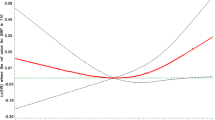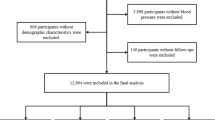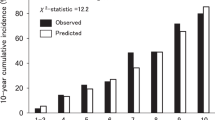Abstract
To evaluate the relationship between blood pressure and cerebrovascular death depending on body mass index (BMI) levels, we analysed a database of 9338 subjects from the National Integrated Project for Prospective Observation of Non-communicable Disease and its Trends in the Aged, which was originally conducted a baseline survey in 1980 and followed up in 1999. Relative risk (RR) and a 95% confidence interval (CI) of death from total stroke, cerebral infarction, and intracerebral haemorrhage after adjusting for age, sex, serum cholesterol, albumin, glucose, the use of antihypertensive agents, a past history of diabetes, BMI, smoking, and drinking were estimated with the Cox-proportional hazard model in the BMI tertile groups of a representative Japanese population. Cutoff points of BMI tertiles are 21.2 and 23.8 kg/m2. The results indicated that a 10 mmHg systolic blood pressure (SBP) increase was associated with mortality from intracerebral haemorrhage at low and middle BMI groups (RR= 1.38 and 1.23; 95% CI=1.17–1.62 and 1.03–1.47, respectively). SBP was positively associated with mortality from cerebral infarction in middle and high BMI groups (RR=1.19 and 1.21; 95% CI=1.06–1.33 and 1.06–1.38, respectively). The effects of diastolic blood pressure on intracerebral haemorrhage and infarction had the same tendency as those of SBP. These results suggested that the causal effect of blood pressure on stroke subtypes might be modified by BMI.
This is a preview of subscription content, access via your institution
Access options
Subscribe to this journal
Receive 12 digital issues and online access to articles
$119.00 per year
only $9.92 per issue
Buy this article
- Purchase on Springer Link
- Instant access to full article PDF
Prices may be subject to local taxes which are calculated during checkout
Similar content being viewed by others
References
Shimamoto T, Iso H, Iida M, Komachi Y . Epidemiology of cerebrovascular disease: stroke epidemic in Japan. J Epidemiol 1996; 6(Suppl 3): S43–S47.
Health and Welfare Statistics and Information Department, Minister's Secretariat, Ministry of Health and Welfare. Health and Welfare Statistics Association, 2003 (in Japanese).
Liu L, Ikeda K, Yamori Y . Changes in stroke mortality rates for 1950 to 1997: a great slowdown of decline trend in Japan. Stroke 2001; 32: 1745–1749.
Rodgers H et al. Risk factors for first-ever stroke in older people in the north East of England: a population-based study. Stroke 2004; 35: 7–11.
Haheim LL, Holme I, Hjermann I, Leren P . Risk factors of stroke incidence and mortality. A 12-year follow-up of the Oslo Study. Stroke 1993; 24: 1484–1489.
Menotti A et al. Twenty-five-year prediction of stroke deaths in the seven countries study: the role of blood pressure and its changes. Stroke 1996; 27: 381–387.
Nippon Data 80 Research Group. Impact of elevated blood pressure on mortality from all causes, cardiovascular diseases, heart disease and stroke among Japanese: 14 year follow-up of randomly selected population from Japanese—Nippon data 80. J Hum Hypertens 2003; 17: 851–857.
Ueshima H et al. Multivariate analysis of risk factors for stroke. Eight-year follow-up study of farming villages in Akita, Japan. Prev Med 1980; 9: 722–740.
Lawes CM et al. Asia Pacific Cohort Studies Collaboration. Blood pressure and cardiovascular disease in the Asia Pacific region. J Hypertens 2003; 21: 707–716.
Solel RC et al. The associations between alcohol drinking and dietary habits and blood pressure in Japanese men. J Hypertens 1995; 13: 587–593.
Curb JD, Marcus EB . Body fat, coronary heart disease, and stroke in Japanese men. Am J Clin Nutr 1991; 53(Suppl 6): 1612S–1615S.
Walker SP et al. Body size and fat distribution as predictors of stroke among US men. Am J Epidemiol 1996; 144: 1143–1150.
Abbott RD et al. Body mass index and thromboembolic stroke in nonsmoking men in older middle age. The Honolulu Heart Program. Stroke 1994; 25: 2370–2376.
Song YM, Sung J, Davey SG, Ebrahim S . Body mass index and ischemic and hemorrhagic stroke: a prospective study in Korean men. Stroke 2004; 35: 831–836.
Kurth T et al. Body mass index and the risk of stroke in men. Arch Intern Med 2002; 162: 2557–2562.
Stamler J, Elliott P, Chan Q, for the INTERMAP Research Group. The INTERMAP study: INTERMAP appendix tables. J Hum Hypertens 2003; 17: 665–775.
Tanaka H et al. Cerebrovascular disease. In: Detels R et al (eds). Oxford Textbook of Public Health, 4th edn. Vol 3. Oxford University Press: Oxford, UK, 2001, pp 1193–1226.
Hayakawa T et al. Prevalence of impaired activities of daily living and impact of stroke and lower limb fracture on it in Japanese elderly people. CVD Prevent 2000; 3: 187–194.
Okamura T et al. Resting heart rate and cause-specific death in a 16.5 year cohort study of the Japanese general publication. Am Heart J 2004; 147: 1024–1032.
Okamura T et al. What cause of mortality can we predict by cholesterol screening in the Japanese general population? J Intern Med 2003; 253: 169–180.
Ueshima H et al. Cigarette smoking as a risk factor for stroke death in Japan: NIPPON DATA80. Stroke 2004; 35: 1836–1841.
Nakamura Y et al. Egg consumption, serum cholesterol, and cause-specific and all-cause mortality: the National Integrated Project for Prospective Observation of Non-communicable Disease and Its Trends in the Aged, 1980 (NIPPON DATA80). Am J Clin Nutr 2004; 80: 58–63.
Nakamura M, Sato S, Shimamoto T . Improvement in Japanese clinical laboratory measurements of total cholesterol and HDL-cholesterol by the US cholesterol reference method laboratory network. J Atheroscler Thromb 2003; 10: 145–153.
Bittner D, McCleary M . The cupric-phenanthroline chelate in the determination of monosaccharides in whole blood. Am J Clin Pathol 1963; 40: 423–424.
Horlick L . Dyslipidemia and metabolic factors in the genesis of heart attack and stroke. Health Rep 1994; 6: 94–99.
Ninomiya JK et al. Association of the metabolic syndrome with history of myocardial infarction and stroke in the third national health and nutrition examination survey. Circulation 2004; 109: 42–46.
Lin RT et al. Metabolic syndrome and its contribution to coronary artery disease in non-diabetic subjects. J Formos Med Assoc 2004; 103: 317–320.
Everson SA et al. Weight gain and the risk of developing insulin resistance syndrome. Diabetes Care 1998; 21: 1637–1643.
Matsuzawa Y et al. Pathophysiology and pathogenesis of visceral fat obesity. Obes Res 1995; 3(Suppl 2): 187S–194S.
Iso H et al. Serum cholesterol levels and six-year mortality from stroke in 350 977 men screened for the multiple risk factor intervention trial. N Engl J Med 1989; 320: 904–910.
Law MR et al. Assessing possible hazards of reducing serum cholesterol. BMJ 1994; 308: 373–379.
Shimamoto T et al. Trends for coronary heart disease and stroke and their risk factors in Japan. Circulation 1989; 79: 503–515.
Kita Y et al. Stroke incidence and case fatality in Shiga, Japan 1989–1993. Int J Epidemiol 1999; 28: 1059–1065.
Sankai T et al. Survival and disability in stroke by stroke subtype based on computed tomographic findings in three rural Japanese communities. Nippon Koshu Eisei Zasshi 1998; 45: 552–563 (in Japanese).
Acknowledgements
This study was supported by the grant-in-aid of the Ministry of Health and Welfare under the auspices of Japanese Association for Cerebro-cardiovascular Disease Control, the Research Grant for Cardiovascular Diseases (7A-2) from the Ministry of Health, Labour and Welfare and a Health and Labour Sciences Research Grant, Japan (Comprehensive Research on Aging and Health: H11-13, Chouju-046, H14-16, Chouju-003). We wish to thank Ms Misao Ohara from the Department of Health Science of Shiga University of Medical Science for her excellent clerical support during this research. We would also like to thank Professor Kazuo Hayakawa and Professor Hiroshi Mikami from the Department of Health Promotion Science of Osaka University for his academic advice.
Author information
Authors and Affiliations
Consortia
Corresponding author
Additional information
Investigators and members of research group are listed in appendix.
Appendix
Appendix
List of the NIPPON DATA80 Research group
NIPPON DATA80: ‘National Integrated Projects for Prospective Observation of Non-communicable Diseases And its Trends in the Aged’.
Chairman: Hirotsugu Ueshima (Department of Health Science, Shiga University of Medical Science, Otsu, Shiga).
Consultant: Osamu Iimura (Hokkaido JR Sapporo Hospital, Sapporo, Hokkaido), Teruo Omae (National Cardiovascular Center, Suita, Osaka), Kazuo Ueda (School of Health Science, Kyushu University, Fukuoka, Fukuoka), Hiroshi Yanagawa (Saitama Prefectural University, Koshigata, Saitama).
Research member: Akira Okayama (Preventive Cardiology National Cardiovascular Disease Center, Suita, Osaka), Kazunori Kodama, Fumiyoshi Kasagi (Radiation Effects Research Foundation, Hiroshima, Hiroshima), Tomonori Okamura, Yoshikuni Kita (Department of Health Science, Shiga University of Medical Science, Otsu, Shiga), Shigeyuki Saito (Internal Medicinell, Cardiology and Nephrology, Sapporo Medical University School of Medicine, Sapporo, Hokkaido), Kiyomi Sakata (Department of Public Health, Wakayama Medical University, Wakayama, Wakayama), Takehito Hayakawa, Shinichi Tanihara (Department of Public Health, School of Medicine, Shimane University, Izumo, Shimane), Yosikazu Nakamura (Department of Public Health, Jichi Medical School, Minami Kawachi, Tochigi), Hiroshi Horibe (Keisen Clinic, Akashi, Hyogo), Masumi Minowa (Department of Epidemiology, National Institute of Public Health, Wako, Saitama).
Research associate member: Toshihiro Takeuchi, Mitsuru Hasebe, Fumitsugu Kusano and members of 300 Public Health Centers in Japan, Katsuhiko Kawaminami (Department of Public Health Policy, National Institute of Public Health, Wako, Saitama), Sohel R Choudhury (Department of Community Medicine, School of Medical Sciences University Sains Malaysia), Yutaka Kiyohara (Department of Medicine and Clinical Science, Graduate School of Medical Sciences, Kyusyu University, Fukuoka, Fukuoka), Minoru Iida (Kansai University of Welfare Sciences, Osaka), Tsutomu Hashimoto (Wakayama Red Cross Blood Center, Wakayama, Wakayama), Atsushi Terao (Hikone Public Health Center, Hikone, Shiga), Koryo Sawai (The Japanese Association for Cerebro-cardiovascular Disease Control, Tokyo, Tokyo), Shigeo Shibata (Clinical Nutrition, Kagawa Nutrition University, Saitama).
Rights and permissions
About this article
Cite this article
Miyamatsu, N., Kadowaki, T., Okamura, T. et al. Different effects of blood pressure on mortality from stroke subtypes depending on BMI levels: a 19-year cohort study in the Japanese general population—NIPPON DATA80. J Hum Hypertens 19, 285–291 (2005). https://doi.org/10.1038/sj.jhh.1001817
Received:
Revised:
Accepted:
Published:
Issue Date:
DOI: https://doi.org/10.1038/sj.jhh.1001817



